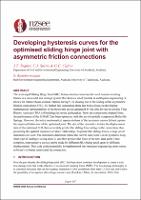Developing hysteresis curves for the optimised sliding hinge joint with asymmetric friction connections

Download
Date
2020-04-22Authors
Togher, Jake
Speirs, Carlos
Clifton, G. Charles
Ramhormozian, Shahab
Metadata
Show full item recordAbstract
The semi-rigid Sliding Hinge Joint (SHJ) beam-column connection for steel moment resisting frames is a successful low damage system that shows a lot of promise in earthquake engineering. It allows for relative beam-column rotation during ULS shaking due to the sliding of the asymmetric friction connection (AFC). To further this connection, there has been a focus on developing mathematical representations of the hysteresis curves generated by the joint for use in seismic Time History Analyses (THA) of buildings in severe earthquakes. From the connections original form, the performance of the SHJAFC has been optimised with the use of partially compressed Belleville Springs. However, the initial mathematical representations of the hysteresis curves did not capture the improved behaviour of the optimised joint. The aim of the research is to take the displacement data of the optimised SHJ, then accurately predict the sliding force acting on the connection, thus presenting the updated moment-curvature relationship. To predict the sliding forces, a large set of statements are used. The statements determine where the current data point is in its hysteretic loop, what type of loading is acting upon it, and then predicts the force of the next data point. Once complete, representative curves can be made for different SHJs being acted upon by different displacements. This code could potentially be implemented into structural engineering open source software’s to better understand the connection.
